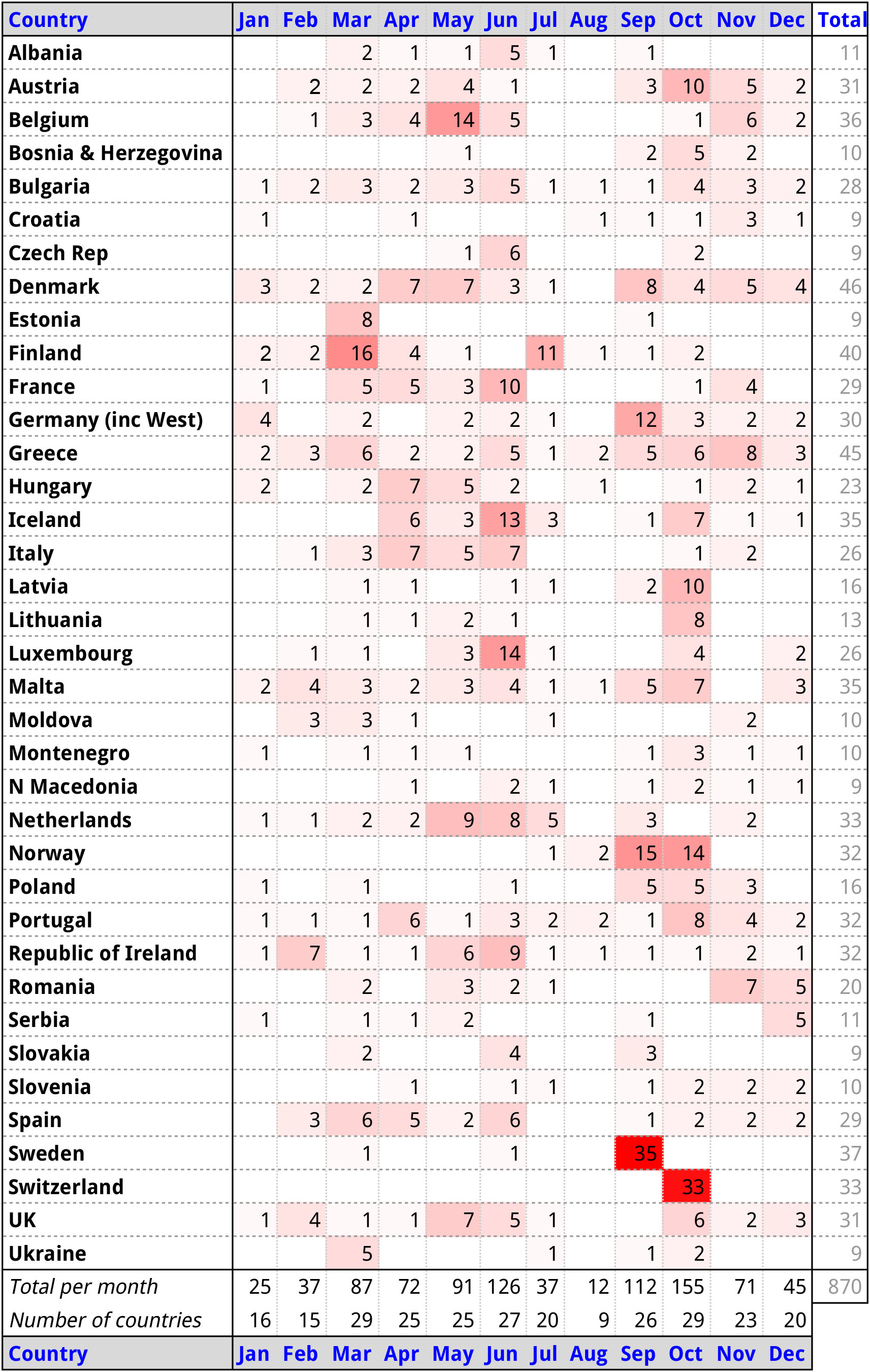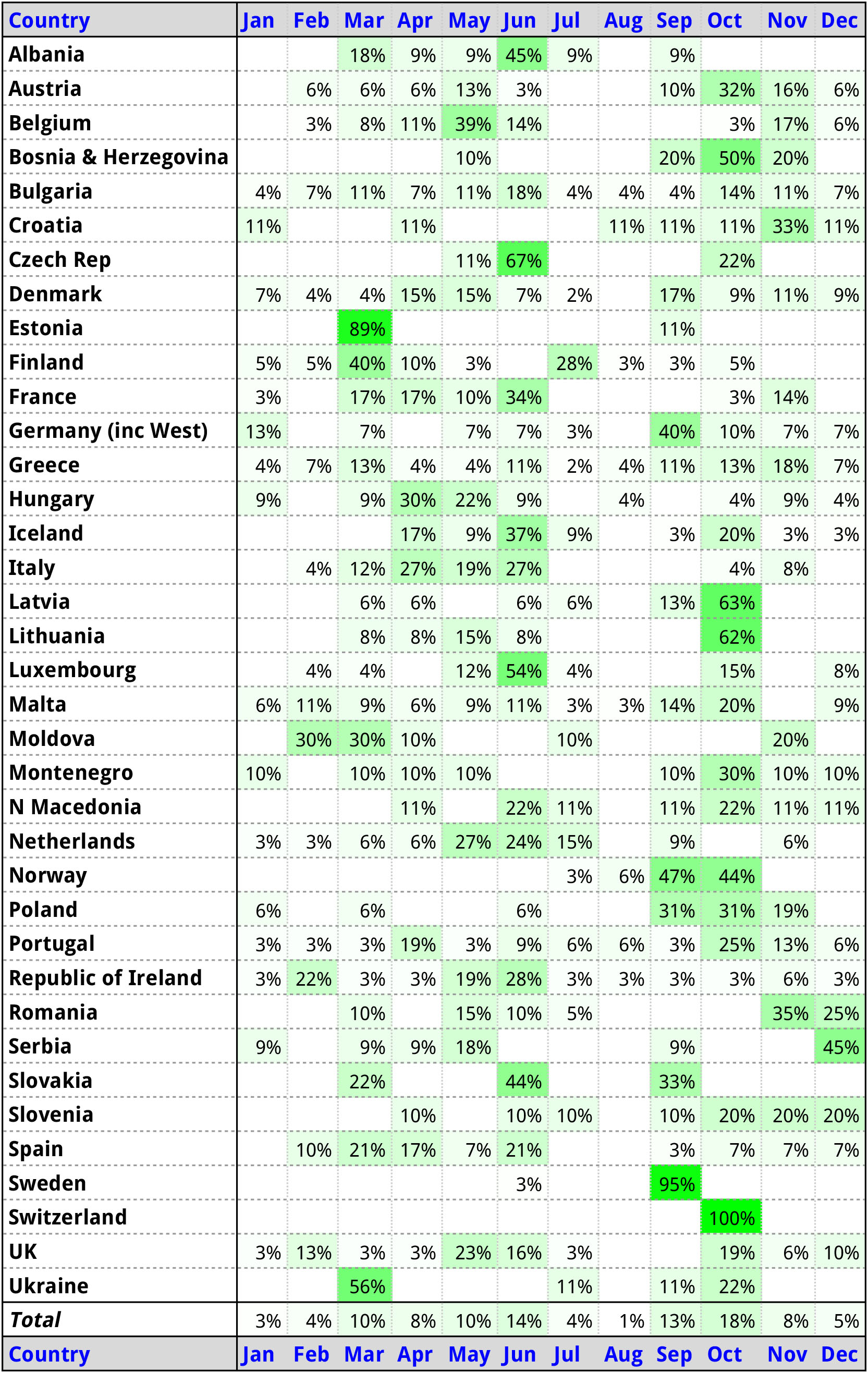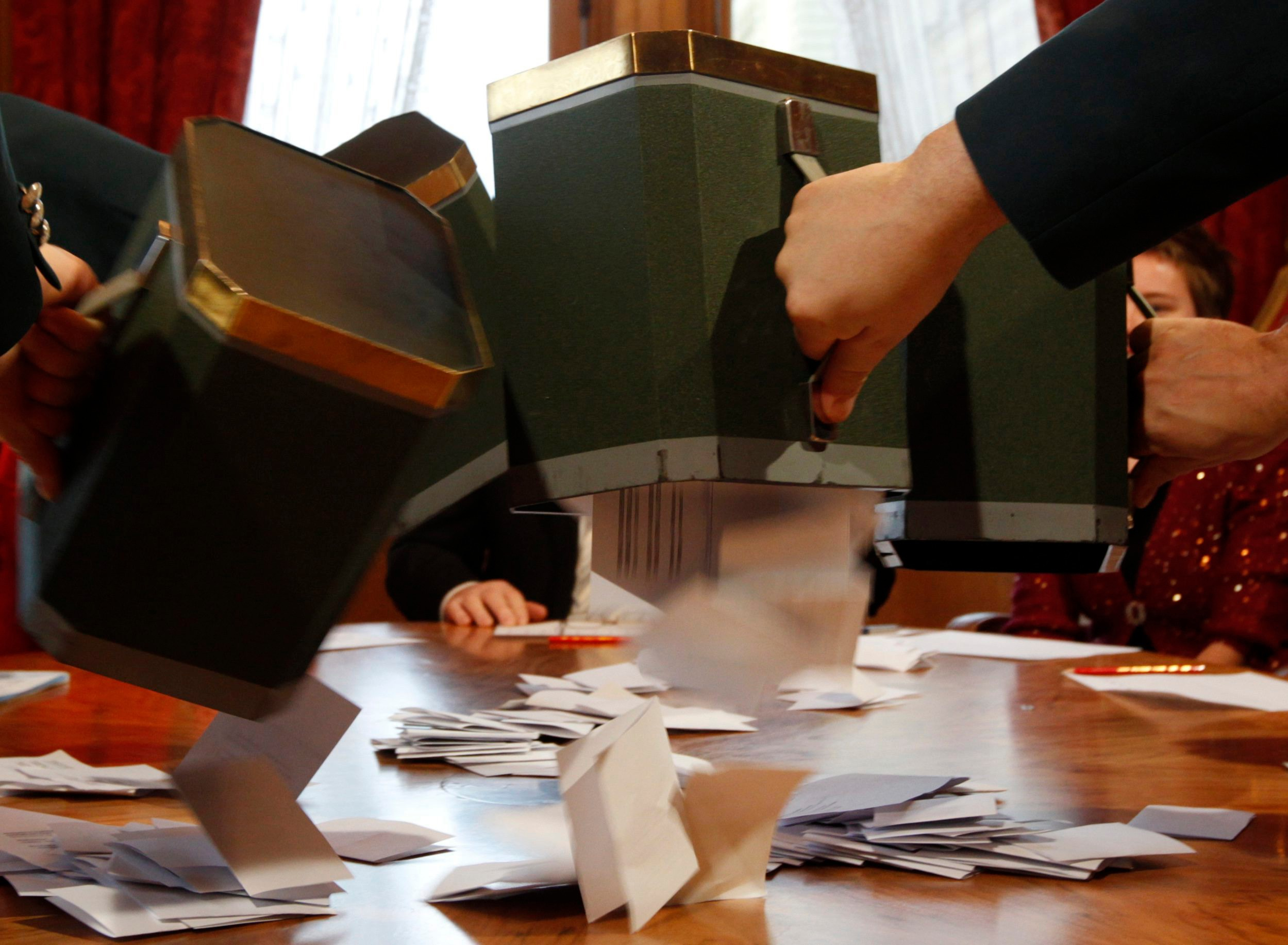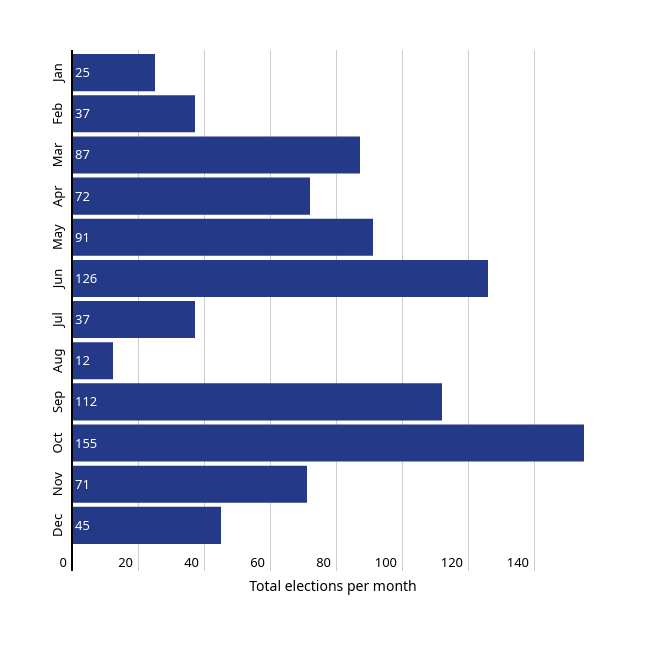In his latest idea to get the UK parliament to approve Brexit, prime minister Boris Johnson has promised (or perhaps threatened) a general election if his deal is approved. The proposed election would take place on 12 December, leading many to claim that winter elections are unusual or even unfair.
However, election timings differ widely across Europe, as can be shown by analysing the months in which votes have taken place. CGTN has crunched the data from various European countries since 1900, concentrating on elections of the largest representative assembly in each country - usually the "lower house", such as the House of Commons in London.
The analysis shows that Europe is a fascinatingly diverse place, but there is one clear favourite month for polling across the continent. You'll have to read to the end to discuss which it is.
First, since it kicked off the debate, let's start with the UK itself…

European countries' national election history since 1900: the numbers
European countries' national election history since 1900: the numbers
Moving around the calendar (or not)
For all the outcry over Johnson's December plan, winter UK elections were the norm at the start of the last century. Of the 11 elections between 1900 and 1939, 10 were held between the months of October and February. Even after the war, political upheaval could trigger elections at any point; regular summer votes only became typical under the settled governments of Margaret Thatcher and Tony Blair.
Other nations have been somewhat more regular. France has voted for its National Assembly in June on eight of the last 11 occasions, although there was at least one March election in each of the last four decades of the 20th century.
The last six German elections have been in September. Indeed, 11 of the 18 elections since World War II in (West) Germany have been in September, with the odd calendrical wobble for special occasions like the December 1990 post-reunification election or the November 72 snap election won by Willy Brandt.
Spain had four successive March elections between 1996 and 2008, but June is also popular: nine of the 14 post-Franco votes have been in March or June. Portugal's election dates are in the gift of the president, but in recent years have always fallen between mid-September and mid-October.
Portugal is the first country on our list so far to have had an August election, although not since 1910 - and even then, before the results could be confirmed, a coup d'etat overthrew the monarchy. Traditionally a holiday month for politicians and public alike, August is the least popular month in our sample, with just a dozen elections since 1900. January (25) is also unpopular, with February and July (37) also overlooked. But there are always exceptions…

Spain's prime minister Pedro Sanchez votes in April - later than most recent elections (AP Photo/Bernat Armangue)
Spain's prime minister Pedro Sanchez votes in April - later than most recent elections (AP Photo/Bernat Armangue)
It's early summer, it's election time
For instance, the Republic of Ireland has generally favored May/June, with an unusual-for-Europe taste for February. But it has broad tastes: its 32 elections (including the 1918 catalyst for independence) have been spread over all 12 months. Only one country has ticked off every month with a smaller total number of elections.
Also jumping about are the Dutch, whose last six elections have all been in different months (the most recent in March having followed September, June, November, January and May), breaking out of the May-to-July monotony of the early 20th century. Next door, Belgium has bounced between May and June for the last seven elections, May having held most of the early 20th-century votes.
Italy's political process may be renowned for its volatility, but Italian elections are reliably in the April-June period: 16 of the 19 since World War II have been in that quarter of the year. Italy hasn't had an election in the second half of the year since 1919.

European countries' national election history since 1900, expressed as a percentage of each country's total
European countries' national election history since 1900, expressed as a percentage of each country's total
How about an autumn election?
Greece is the cradle of democracy: the very word comes from the Greek for "people" (demos) and "kratos" (power or rule). The country has had 45 elections since 1900, with at least one in each calendar month, but a clear preference for late autumn of September-November.
Further north, Switzerland has a reputation for orderly reliability, and it shows in the clockwork regularity of Swiss elections. Since its federal establishment in 1848, Switzerland has held all 51 of its elections in late October. It helps, too, that the party political situation is rarely volatile, with the public regularly consulted via referenda.
Austria, too, has a history of October voting and has settled back into a late September or early October pattern since the early 1980s, even for snap elections like the one caused by the collapse of the Grand Coalition in 2008.
Other countries in a vertical slice of central Europe also tend to be regular with their elections. Poland's last nine have been in September or October. Hungary's post-Soviet elections have all started in a seven-week window around April. The six Romanian elections since 1992 have been in November/December; between the two world wars, they were often held in late December.

The Swiss vote a lot, but their national assembly elections are always in October (Credit: AP Photo/Keystone, Michael Buholzer)
The Swiss vote a lot, but their national assembly elections are always in October (Credit: AP Photo/Keystone, Michael Buholzer)
Nordic reliability (mostly)
If you like your election timing stable, head to Scandinavia and the Baltics. Norway's last 15 elections have been in September, the previous 14 were in October, and although the one before that (in 1906) started daringly early in August, it dragged on into October. Sweden almost always votes in September - the exceptions were emergency elections in June 1958 and March 1914.
Finland's first election was in March, its second in July, and it has modulated between the two ever since: July was popular during the early 20th century, but the 11 elections since 1979 have been in March or April. The newer Baltic nations have also settled in via regularity: Lithuania's last seven elections have been on the second Sunday in October, and Latvia's are on the first Saturday of that month, whereas Estonia votes in March.
Down at the relatively temperate end of Scandinavia, Denmark has enjoyed elections in a variety of different months. In the early 20th century, April and May were the norm, but since then the month has ricocheted all over the calendar; September leads the way with eight in total, but only three of the last 17. (In August, parliament is in recess and most Danes are on holiday.)
Also on the move is Iceland. Until the late 1970s, elections tended to be held in June, when daylight hours are helpfully long at Icelandic latitudes; however, none of the 12 votes since 1978 has been in June. More recently, after seven successive Junes, Luxembourg has switched to October since Jean-Claude Juncker's resignation as prime minister over a spy scandal.

Bjarni Benediktsson, then Iceland's prime minister, votes in October 2017 (Credit: AP/Brynjar Gunnarsson)
Bjarni Benediktsson, then Iceland's prime minister, votes in October 2017 (Credit: AP/Brynjar Gunnarsson)
Political manoeuvrings
The problem with trying to time elections is that politics can get in the way. The first six Czech elections after 1989 were in June, but the last two have been in October. Slovakia started in June but has since included September and March, with one to come next February.
Ukraine's first five since 1990 were in March, but timings since have been at the mercy of political developments. Five of Serbia's first six over the same period were held in December, since when they have tiptoed into the first half of the calendar. Going in the other direction, elections in Bosnia and Herzegovina have settled into October, but Croatia's dates have refused to stay anywhere, although they tend to be late in the year.
Indeed, the Balkans sum up Europe's split personality. Albania has settled into June or thereabouts, but others have danced about. In both Slovenia and Bulgaria, the 10 elections since 1990 have been held in seven different months, North Macedonia's nine over seven months, while Montenegro's 10 have been spread over eight different months. Since 1900, Bulgaria has covered each of the 12 calendar months in just 28 elections - making it the most efficient European nation at ticking every calendar box.

Europe's favorite months
So which is the most popular month for national elections in Europe? In the grand tradition, let's reveal the top three in reverse order. In third place, with 112 elections since 1900, is September, boosted by the 35-election block vote from Sweden and strong showings from Norway (15) and Germany (12).
In second place, with 126 elections is June; although used by fewer countries (27) than March (29, but just 87 elections in total), June has shown enduring popularity from Luxembourg (14) and Iceland (13) and 10 other countries with five or more elections.
But there can only be one winner. Chosen an unassailable 155 times between 29 countries from Norway (14) to Austria (10), but mainly bolstered by that unswerving block vote from Switzerland (33), Europe's favorite month for elections is... October.
Read more Interactive chart of each country's election months at CGTN Europe's Facebook page